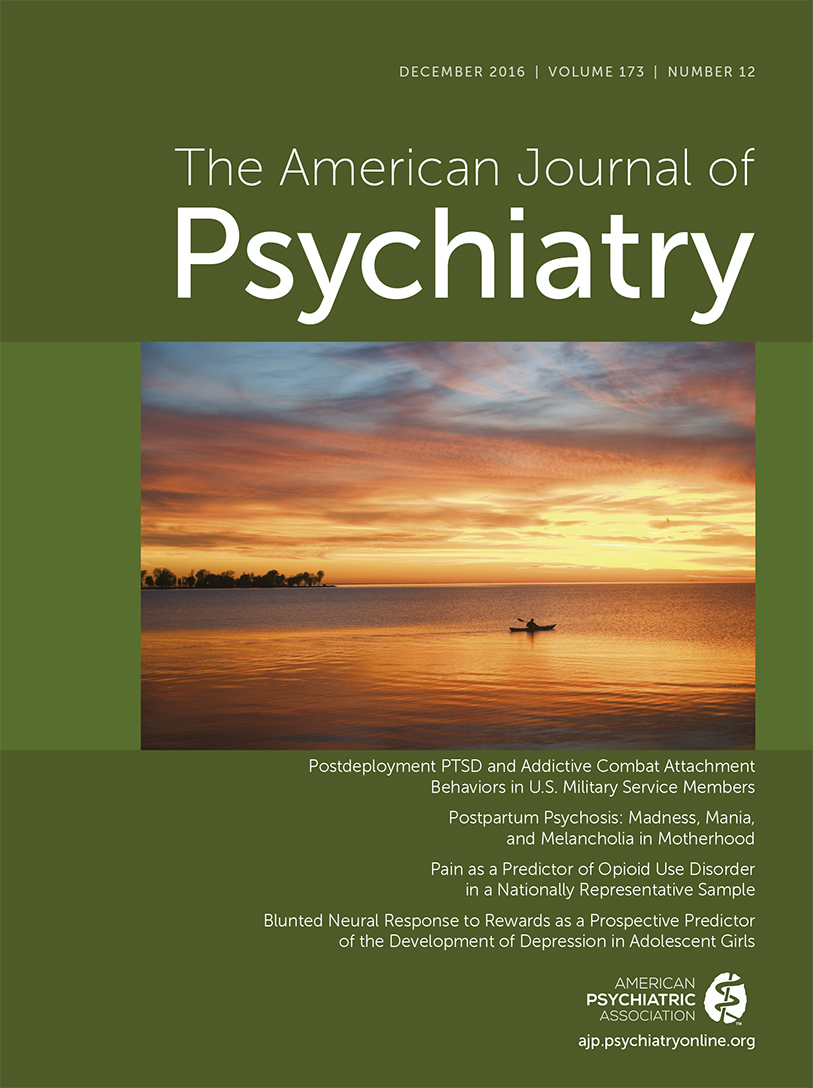Efficacy of Quetiapine Monotherapy in Posttraumatic Stress Disorder: A Randomized, Placebo-Controlled Trial
References
- 1 : Posttraumatic stress disorder in the National Comorbidity Survey. Arch Gen Psychiatry 1995; 52:1048–1060 Crossref, Medline, Google Scholar
- 2 : Combat duty in Iraq and Afghanistan, mental health problems, and barriers to care. N Engl J Med 2004; 351:13–22 Crossref, Medline, Google Scholar
- 3 : Diagnostic and Statistic Manual for Mental Disorders, 5th ed. Washington, DC, APA, 2013 Crossref, Google Scholar
- 4 : Psychotic features and combat-associated PTSD. Depress Anxiety 1997; 5:34–38 Crossref, Medline, Google Scholar
- 5 : Psychotic symptoms in combat-related posttraumatic stress disorder. J Clin Psychiatry 1999; 60:29–32 Crossref, Medline, Google Scholar
- 6 : Psychotic features in chronic posttraumatic stress disorder and schizophrenia: comparative severity. J Nerv Ment Dis 2000; 188:217–221 Crossref, Medline, Google Scholar
- 7 : Effective Treatments for PTSD: Practice Guidelines From the International Society for Traumatic Stress Studies. New York, Guilford Press, 2008 Google Scholar
- 8 : Fluoxetine in posttraumatic stress disorder. J Clin Psychiatry 1994; 55:517–522 Medline, Google Scholar
- 9 : Lack of efficacy for fluoxetine in PTSD: a placebo controlled trial in combat veterans. Ann Clin Psychiatry 2000; 12:101–105 Crossref, Medline, Google Scholar
- 10 : Double-blind placebo-controlled pilot study of sertraline in military veterans with posttraumatic stress disorder. J Clin Psychopharmacol 2002; 22:190–195 Crossref, Medline, Google Scholar
- 11 : Bupropion treatment in veterans with posttraumatic stress disorder: an open study. J Clin Psychopharmacol 1998; 18:379–383 Crossref, Medline, Google Scholar
- 12 : Adjunctive risperidone treatment in post-traumatic stress disorder: a preliminary controlled trial of effects on comorbid psychotic symptoms. Int Clin Psychopharmacol 2003; 18:1–8 Crossref, Medline, Google Scholar
- 13 : Treatment-resistant posttraumatic stress disorder: strategies for intervention. CNS Spectr 2004; 9:740–752 Crossref, Medline, Google Scholar
- 14 : Prospective study to evaluate the efficacy of aripiprazole as a monotherapy in patients with severe chronic posttraumatic stress disorder: an open trial. Psychopharmacol Bull 2007; 40:6–18 Medline, Google Scholar
- 15 : Adjunctive olanzapine for SSRI-resistant combat-related PTSD: a double-blind, placebo-controlled study. Am J Psychiatry 2002; 159:1777–1779 Link, Google Scholar
- 16 : Olanzapine monotherapy in posttraumatic stress disorder: efficacy in a randomized, double-blind, placebo-controlled study. Hum Psychopharmacol 2012; 27:386–391 Crossref, Medline, Google Scholar
- 17 : A review of atypical antipsychotic medications for posttraumatic stress disorder. Int Clin Psychopharmacol 2011; 26:193–200 Medline, Google Scholar
- 18 : Adjunctive risperidone treatment for antidepressant-resistant symptoms of chronic military service-related PTSD: a randomized trial. JAMA 2011; 306:493–502 Crossref, Medline, Google Scholar
- 19 : Binding of antipsychotic drugs to human brain receptors focus on newer generation compounds. Life Sci 2000; 68:29–39 Crossref, Medline, Google Scholar
- 20 : Quetiapine affects neuropeptide Y and corticotropin-releasing hormone in cerebrospinal fluid from schizophrenia patients: relationship to depression and anxiety symptoms and to treatment response. Int J Neuropsychopharmacol 2012; 15:1051–1061 Crossref, Medline, Google Scholar
- 21 : Active metabolites as antidepressant drugs: the role of norquetiapine in the mechanism of action of quetiapine in the treatment of mood disorders. Front Psychiatry 2013; 4:102 Crossref, Medline, Google Scholar
- 22 : Quetiapine treatment in patients with posttraumatic stress disorder: an open trial of adjunctive therapy. J Clin Psychopharmacol 2003; 23:15–20 Crossref, Medline, Google Scholar
- 23 : Quetiapine improves sleep disturbances in combat veterans with PTSD: sleep data from a prospective, open-label study. J Clin Psychopharmacol 2005; 25:387–388 Crossref, Medline, Google Scholar
- 24 : Prazosin versus quetiapine for nighttime posttraumatic stress disorder symptoms in veterans: an assessment of long-term comparative effectiveness and safety. J Clin Psychopharmacol 2010; 30:225–229 Crossref, Medline, Google Scholar
- 25 : VA/DoD Clinical Practice Guideline for the Management of Post-Traumatic Stress, 2010 ( http://www.healthquality.va.gov/guidelines/MH/ptsd/cpgPTSDFULL201011612c.pdf) Google Scholar
- 26 : The development of a Clinician-Administered PTSD Scale. J Trauma Stress 1995; 8:75–90 Crossref, Medline, Google Scholar
- 27 : Structured Clinical Interview for DSM-IV-TR Axis I Disorders, Research Version, Patient Edition. (SCID-I/P). New York, New York State Psychiatric Institute, Biometrics Research, 2002 Google Scholar
- 28 : Off-label use of second generation antipsychotics for post-traumatic stress disorder in the Department of Veterans Affairs: time trends and sociodemographic, comorbidity, and regional correlates. Pharmacoepidemiol Drug Saf 2014; 23:77–86 Crossref, Medline, Google Scholar
- 29 : The use of second generation antipsychotics for post-traumatic stress disorder in a US Veterans Health Administration Medical Center. Epidemiol Psychiatr Sci 2014; 23:281–288 Crossref, Medline, Google Scholar
- 30 : Quetiapine monotherapy for bipolar depression. Neuropsychiatr Dis Treat 2008; 4:11–21 Medline, Google Scholar
- 31 : Pharmacotherapy of PTSD in the U.S. Department of Veterans Affairs: diagnostic- and symptom-guided drug selection. J Clin Psychiatry 2008; 69:959–965 Crossref, Medline, Google Scholar
- 32 : A trial of prazosin for combat trauma PTSD with nightmares in active-duty soldiers returned from Iraq and Afghanistan. Am J Psychiatry 2013; 170:1003–1010 Link, Google Scholar
- 33 : Plasma prolactin in schizophrenia subjects treated with Seroquel (ICI 204,636). Psychopharmacol Bull 1996; 32:107–110 Medline, Google Scholar
- 34 Benedek DM, Friedman MJ, Zatzick D, Ursano RJ: Guideline Watch (March 2009): Practice Guideline for the Treatment of Patients With Acute Stress Disorder and Posttraumatic Stress Disorder. ( http://psychiatryonline.org/pb/assets/raw/sitewide/practice_guidelines/guidelines/acutestressdisorderptsd-watch.pdf) Google Scholar
- 35 : Antipsychotic medications: metabolic and cardiovascular risk. J Clin Psychiatry 2007; 68(suppl 4):8–13 Crossref, Medline, Google Scholar



